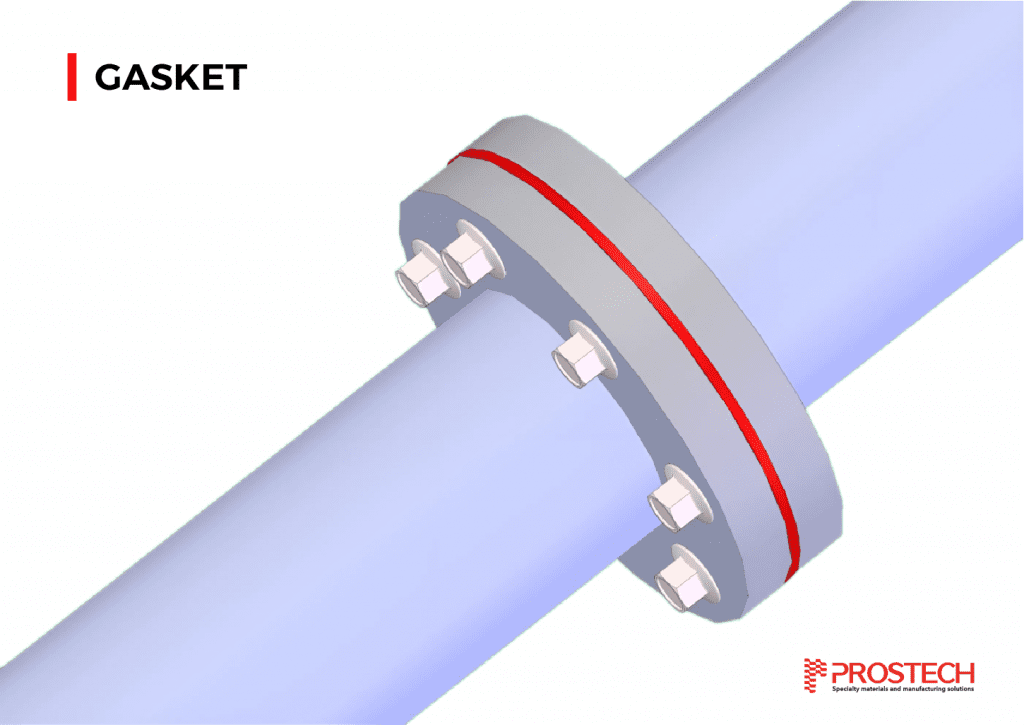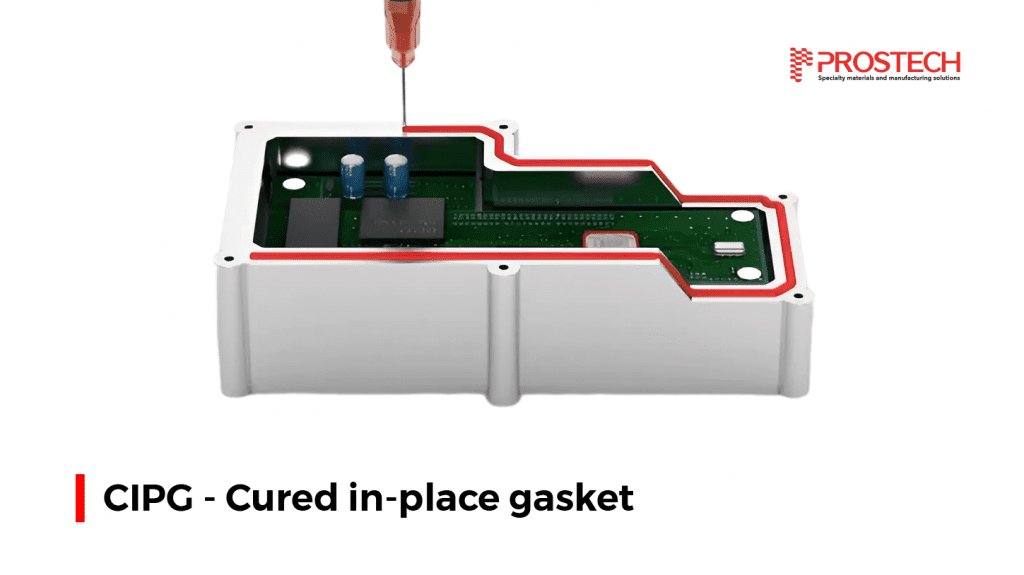In today’s industrial landscape, achieving robust seals between mating surfaces is crucial for operational efficiency and safety. FIPG and CIPG stand as innovative solutions, offering versatility in addressing diverse sealing requirements across industries. Throughout this guide, we will explore the fundamental principles, applications, advantages, and implementation considerations of both techniques to optimize your production process.
1. Overview of Gasket – FIPG and CIPG

A gasket is defined as a material placed between two flange faces held together by bolts. Its primary function is to prevent leakage of liquid or gas by completely filling the voids between the flange surfaces, thereby ensuring a leak-free seal over an extended period. Gaskets are designed to withstand sealed environments characterized by factors such as temperature, pressure, vibration, etc.
Formed In-Place Gasket (FIPG) and Cured In-Place Gasket (CIPG) are two techniques widely used across various industrial applications to create seals between mating surfaces, replacing traditional gasket types. Although both methods involve creating on-site gaskets, they are applied in different fields based on the characteristics inherent to each technique.
2. Key Features and Applications of Each Type
1. FIPG – FORMED IN PLACE GASKET

FIPG – The method involves applying adhesive to one flange surface and assembling the remaining flange surface together. After assembly, the sealant will spread out, filling voids with scratches and any unevenness on the mating surface. The adhesive adheres to both the top and bottom surfaces, preventing leakage through its own adhesive force generated after appropriate heat treatment or chemical reaction.
Typically, to achieve the necessary sealing performance on multiple such surfaces, the two most used materials are room-temperature vulcanizing silicone (RTV) and anaerobic compounds, especially for lightly clamped and flexible flanges.
When is the FIP method applied?
- When flexibility is needed in the installation process.
- In applications requiring high-temperature resistance, chemical resistance, or pressure resistance that conventional gaskets may not meet.
- When the mating surfaces have complex shapes.
- Suitable for long-term connections without frequent maintenance.
Advantages of FIPG
- Reliable sealing capability: FIPG creates a reliable seal to protect against dust, water, and other elements:
-
- Seals all surface imperfections.
-
- Reduces bolt compression and loosening.
- The airless type can enhance mechanical properties for assembled joints.
- Integration of assembly to improve torque transmission between bolted flange joints.
- Easy to use:
-
- Single-component type does not require mixing.
- Can be applied semi-automatically or fully automatically.
- Can be assembled immediately after adhesive application.
Disadvantages of FIPG
- Limitations in thickness.
- Not suitable for high pressure.
- Slow drying rate: Some types of FIP gaskets have a slow drying rate.
- Difficult to remove.
Each type of gasket method has its own disadvantages, depending on the environment of use, we will have suitable choices. The drawbacks of FIPG are not an issue, as Prostech always proposes solutions that meet all your production requirements.
2. CIPG – CURE IN PLACE GASKET

CIP (Cure-in-Place) – in contrast to FIP (Form-In-Place), adhesive sealants are cured prior to assembly, which can be accomplished through rapid UV curing, heat processing, two-part mixing, or slow moisture curing, ranging from minutes to several days. Slower production rates are advantageous for slower curing methods to avoid costly equipment downtime. However, there is a risk of parts becoming contaminated or damaged during curing, hence generally prioritizing short-duration UV curing methods. CIPG is commonly applied in highly automated manufacturing processes.
CIPG and gaskets prevent leakage by their own compression reaction force when tightly squeezed.
When is the CIP method applied?
- CIPG is often used when a gasket is needed to withstand high pressure.
- When adhesion to both surfaces is not required.
- When high precision in gasket size and shape after curing is needed.
- When reducing waiting time for the curing process, especially in mass production.
- For parts requiring extremely high sealing and durability in harsh environments.
- When manufacturing technology allows precise control of curing conditions, such as pressure, temperature, or UV radiation.
- When joints need regular maintenance.
Advantages of CIPG
- Fast curing time: CIPG can often cure quickly after application, reducing waiting time and increasing production efficiency.
- High precision: CIPG is suitable for applications requiring high precision in gasket shape and size.
- Heat and chemical resistance: Many types of CIPG have good heat and chemical resistance, suitable for harsh environments.
- Flexible thickness: CIPG can create gasket layers with various thicknesses, from thin to thick.
Disadvantages of CIPG
- Higher cost: Due to requiring more complex equipment, production costs are generally higher than FIPG.
- High technical requirements: Specialized technical expertise and equipment are needed to apply and control the curing process of CIPG.
- Limited flexibility: CIPG is often not as flexible as FIPG in application on different surfaces and shapes.
Prostech, along with experienced experts in the field of gaskets, possesses a deep understanding of the intricacies involved in selecting appropriate types or utilizing CIPG. Contact us to receive valuable information and consultation from our qualified experts.
3. FIPG-CIPG in comparison to Traditional Solid Gasket
|
|
Liquid gaskets |
Solid gasket |
||
|
FIPG |
CIPG |
|||
|
Method |
Moisture-curing |
UV-curing |
Molding |
|
|
Sealing |
 |
|
|
|
|
Process speed |
Curing speed |
Fair |
Equal |
Excellent |
|
Line configuration |
Automation |
Equal |
Equal |
Fair |
|
Administration |
Equal |
Equal |
Fair |
|
|
Design flexibility |
Shape change |
Equal |
Equal |
Fair |
|
Removability |
Fair |
Equal |
Excellent |
|
4. How to Choose Adhesive for FIPG-CIPG
To choose the suitable type of Adhesives for FIPG – CIPG in various application, we must take into consideration the following factors:
- Material of the mating flange surfaces
- Hardness of the flange surface
- Bolt position and spacing
- Strength and length of bolts
- Flange design
- Surface structure
- Adhesive strength
- Durability
- Flexibility/elasticity/expansion capability
- Appearance
- Application method (related to the gasket’s curing time)
Currently, two types of materials are commonly used for these two applications: anaerobics and silicone RTV. The decision to use anaerobic materials versus silicone materials relates to several issues. Anaerobics are typically used on rigid joints, such as cast aluminum or iron. Typical applications include pumps, engines, and gearboxes. These joints usually experience less movement compared to joints using stamped steel or cast plastic. Meanwhile, silicone RTV is used for joints with higher movement.
1. Anaerobic
Anaerobic materials cure in situ in the absence of air and in the presence of metal or other active surfaces. The cure speed at room temperature ranges from a few minutes to several hours. Due to the absence of solvents, the conversion from liquid to solid is nearly 100%, thus filling voids on the surface perfectly and completely sealing potential leakage paths.
Advantages of anaerobic gaskets
- Ensures proper bolt tension throughout the assembly’s lifespan without the need for re-tightening.
- Allows metal-to-metal contact on the flange surface, maintaining precise tolerance without the need for gasket thickness allowance.
- High shear strength anaerobic gaskets can prevent movement due to external loads, eliminating bolt loosening and flange face abrasion, and enhancing assembly integrity.
- Excess material remains liquid, sealing only between flange surfaces and easily cleaned off.
- Surface finish relaxation: Allows for surface finish imperfections and flatness tolerance without the need for re-machining.
- Inventory cost reduction.
- Excellent chemical compatibility, resisting most industrial chemicals, oil-based fuels, lubricants, and water/glycol mixtures.
Disadvantages of anaerobic gaskets
- Anaerobic gaskets can limit flange movement due to differential thermal expansion or applied loads. However, if the external force exceeds the material’s shear strength or tensile strength, the long-term sealing ability of the assembly will be compromised, like most conventional gaskets. This relative movement needs to be controlled through design.
- Anaerobic gaskets are thermosets plastics with typical operating temperature ranges from -50°C (-58°F) to +150°C (+302°F); some materials can withstand temperatures up to +204°C.
2. Silicone RTV Gaskets
Silicone RTV material cures by reacting with atmospheric moisture. Flowing silicone compounds form complete fills, sealing all voids. They exert a slight amount of pressure both inside and outside the joint. Excess material is squeezed out around the edges of the flange, forming a secondary sealing bead. Silicone RTV materials are solvent-free. The conversion from liquid to solid is nearly 100%, eliminating all potential leakage paths.
Advantages of silicone RTV gaskets
- Seals large gaps: Silicone RTV materials seal gaps up to 6mm wide.
- Flexibility with flange movement: Silicones have high elongation properties, up to 600%, allowing them to move in joints with high differential thermal expansion or flexible flanges.
- Silicone gasket materials allow for surface finish imperfections and flatness tolerance adjustments. In some cases, their ability to fill large gaps allows these materials to be used on pre-cast surfaces.
- Inventory cost reduction: Like anaerobic materials, silicone eliminates the need for large and costly gasket inventories.
- Silicone RTV has a temperature range from -70°C (-94°F) to +260°C (+500°F), with intermittent exposure up to +315°C (+599°F). Special products are available for intermittent temperatures up to +343°C (+649°F).
- Excellent adhesion properties: Silicone RTV material adheres well to many surfaces.
Disadvantages of silicone RTV gaskets
- Limited chemical compatibility: Some silicone RTV materials are limited in sealing oils, coolants, and air. They have poor resistance to fuels and aromatic solvents.
- Silicones are not suitable for high-pressure applications due to their high elongation and low tensile and sheer strength. It is difficult to define an absolute high-pressure limit, but pressures above 100 psi are considered high-pressure systems.
5. Conclusion
In conclusion, the selection of the right adhesive for sealing applications, such as FIPG or CIPG, is a critical aspect of ensuring the integrity and longevity of various assemblies. Factors such as flange material, bolt characteristics, application method, and environmental conditions all play crucial roles in determining the most suitable adhesive type. With Prostech’s expertise and experience in the gasket field, customers can trust in their ability to navigate these complexities and make informed decisions that enhance the performance and reliability of their systems.
—————————————–
For more information, contact us to talk with our glue experts:




